Alexandra Mazo Prof. Julia Keefer
August 02, 2000
Thesis: During the 19TH century respirators played a big roll in medicine. Hospitals, patients, and families relied on this equipment to keep patients and loved ones breathing. And still in the 20th century respirators better known as ventilators are still making history and most important of all saving lives.
RESPIRATION: The act or process by which the human body inhales and exhales air. Exchanging oxygen and carbon dioxide between an organism and the environment.
RESPIRATOR:
a. A device that supplies oxygen or a mixture of oxygen 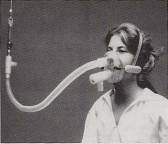
and carbon dioxide for breathing, used specially in artificial respiration.
b. A procedure to restore respiration in a person who has stopped breathing by forcing air into and out of the lungs in a rhythmic breathing fashion.
HISTORY
The development of respirators as a life support system can be traced to the work of Paul Bert, A 19th century French physiologist, engineer, and physician. During the 1870”s Bert conceptualized the basic principle of using supplementary oxygen to supply balloonist and mountain climbers who had ascended beyond the levels at which the oxygen in the air is sufficient for breathing. Two of Bert’s colleagues took a supply of about 150 litters of 70 percent oxygen on a balloon flight in 1875; but they fail to use it soon enough, and only one of the two survived. On this flight the air was stored at ambient pressure in “goldbeater bags”(made from cow intestines) and was inhaled by mouth tube through a humidifier containing an aromatic liquid whose purpose was both to humidify the gas and to counteract the odour of the bags. Bert also design a tank and the regulator system of capacity of 300 litters where by mountain climbers could breath oxygen near the peak on their ascent.
Since Bert’s pioneering efforts, various kind of sophisticated of life support systems have been developed. Such as the iron lung machine, respirators (ventilators) and other variety of devices use for mechanical ventilation.
RESEARCH
Respirator were one of the most frequently used methods of mechanical ventilation in hospitals during the 19th century since then this devices have been upgraded for more efficiency and to meet patient’s needs. Conventional physiologic interventions in pulmonary rehabilitation include administration of oxygen, physical exercise conditioning, breathing exercises; respiratory muscle training is a more recent modality. Among these, only the administration of oxygen has been shown to prolong life.
How should patients be selected for newly discovered
techniques? What patters of mechanical ventilation is most comfortable, and
why? What are the optimal ways of delivering mechanical ventilation to different
types of patients?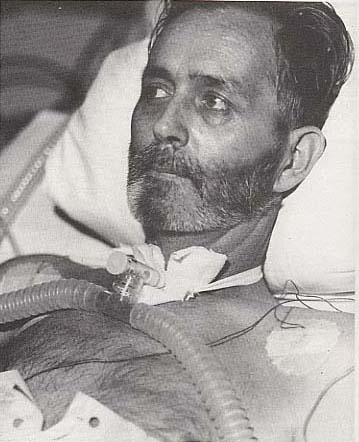
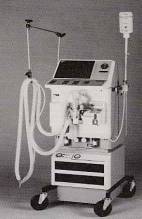
There are two different types of classifications on ventilators. Positive-pressure ventilators, are for those patients who have problems starting respiration and ending respiration. Negative-respiration ventilators, are mostly use in patients prone to pulmonary infections or other problems associated with artificial airways. Patients with low ventilatory reserve often require mechanical ventilatory support for prolong periods. Familiarity with methods and features of devices the used for ventilatory assistance is essential for their proper use. For example some allow a better quality of life than others by permitting greater mobility, safety, or comfort. Provision of mechanical ventilatory support without intubating the trachea is major concern of proper management. Sometimes attention focus on ventilatory support that can alternate with spontaneous breathing. To accomplish the goal of avoiding intubation, one can use body ventilators, positive pressure devices delivering air via facial interfaces, and other methods. Although long -term mechanical ventilatory support can reduce morbidity, decrease duration of hospitalization, and prolong life in neuromuscular and chest wall diseases, its value in COPD (chronic obstructive pulmonary diseases) is less certain.
Mechanical ventilators are not only use on patients
with breathing problems. 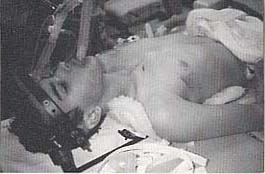 Major surgical operations on the heart have been possible by the development
of heart-lung machines, also referred to as pump-oxygenators. These devices
take over the function of the heart and lungs while those organs are temporarily
stopped. The apparatus is usually connected to the patient’s vascular and
respiratory system. Ventilators are also use for patients who have suffered
heart attacks, seizures and strokes.
Major surgical operations on the heart have been possible by the development
of heart-lung machines, also referred to as pump-oxygenators. These devices
take over the function of the heart and lungs while those organs are temporarily
stopped. The apparatus is usually connected to the patient’s vascular and
respiratory system. Ventilators are also use for patients who have suffered
heart attacks, seizures and strokes.
The Iron Lung
The first iron lung to have widespread use was invented
by Drinker and Shaw in 1928 and was produced by J.H. Emerson Company. It
consisted of an airtight cylinder that enclosed the patient up to his neck.
A seal was formed with foam rubber around the neck so that there was no leak.
The cylinder made isolation of the patient’s body unavoidable, and even ports
of the side made it difficult to provide adequate patient care. The Iron
Lung was use mostly on patients that needed to be treated with negative pressure
ventilators. It was a standard ventilator for both acute and long-term respiratory
support from 1931 to 1956.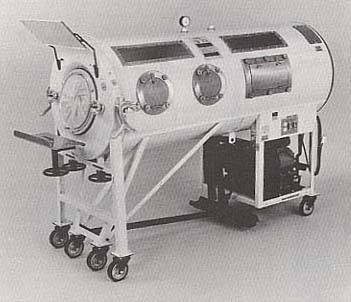
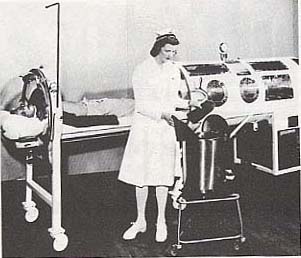
Diseases In which ventilator are required for the survival of the patient.
Duchenne Muscular Distrophy Ventilator
Here is a duchenne muscular distrophy ventilator
user with no ventilator-free breathing ability being transferred from bed
by Hoyer lift. With his feet on the ground, thighs applying pressure to the
abdomen, and buttocks in optimal dependent position, his bowel movements are
initiated and rapidly completed using the hoyer lift in this manner as part
of a bowel program.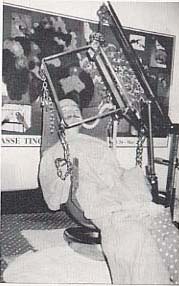
Amyotrophic Lateral sclerosis
Is a disease of unknown etiology of upper and lower
motor neurons. Five to ten percent of cases have an autosomal dominant pattern
of transmission. 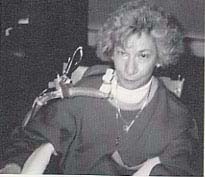 Although the disease affects about the ten percent of the population of Guam,
it has an incidence of about 1/1800 in the United States. ALS most often presents
in middle age but can begin before age thirty. The first symptoms and signs
are usually muscle cramps, weakness, and fasciculation. However, fatigue,
dyspnea, slurred speech, dysphagia, and hypophonia may be initial symptoms.
The rate of disease progression is highly variable. It has been estimated
that 15% to 20% of all patients have less than 5-year survival without ventilatory
support.
Although the disease affects about the ten percent of the population of Guam,
it has an incidence of about 1/1800 in the United States. ALS most often presents
in middle age but can begin before age thirty. The first symptoms and signs
are usually muscle cramps, weakness, and fasciculation. However, fatigue,
dyspnea, slurred speech, dysphagia, and hypophonia may be initial symptoms.
The rate of disease progression is highly variable. It has been estimated
that 15% to 20% of all patients have less than 5-year survival without ventilatory
support.
The following is a brief story of a personal experience with mechanical ventilators.
On June 22, 2000 one of my closest relative Francisco Collado, Age 42 and a previous diabetic suffered a massive stroke, completely paralyzing the whole right side of his body, leaving him without speech for the rest of his life. Francisco was immediately placed in an artificial respirator in case he would stopped breathing on his own, he was given 72 hrs by his doctor to regain consciousness. Three days past and he was still unconscious at this point our family was very confused and didn’t know whether to keep him in the respirator or to just leave him alone and let destiny take its coarse. Finally his wife Maribel made the final decision to keep him connected to the respirator and give him a chance to positively react with the support of the equipment. After two weeks of uncertainty Francisco responded by at least opening his eyes, although he wasn’t able speak, this was a great hope for our family and most important of all for his wife and kids. After this event, Maribel told me that she knew that by keeping Francisco connected to a respirator it would stimulate his system and give him some kind of support to help him go on and Fight against his condition. She also stated that now more than ever she is willing to try any equipment that is willing to keep him alive for his family and his three children. He’s got a lot to live for!
Personal thought
We have to remember that we’ve already intervened beyond what nature intended when we put a patient in a ventilator or an artificial respirator. We are trying to keep two Standards. On the other hand, We want to offer our love ones the latest in technology; on the other hand, nobody wants the responsibility of making decisions that may arise because of our actions.
I think we are going to have to make decisions that we are not used to making and that are uncomfortable. We have to explore all options With family members and close friends. But like I was able to show you respirators, ventilators and all other devices that helps our respiratory system function properly, has to be considered a great creation, because oxygen is all we need to live.
BIBLIOGRAPHY
Bach John R. MD, The Obstructive and Paralytic Conditions of
Pulmonary Rehabilitation. Hanley & Belfus, Inc. 1996
- Carroll Charles. Ethical Dilemmas in Respiratory Care
F.A. DAVIS COMPANY. Philadelphia 1996.
- Internet. www.about.com Artificial Respiration.
- Johnson L. Dawn, Giovannoni M. Rita, Driscoll A. Susana
(1986). Ventilator Assisted Patient care. Mass.
Aspen Publishers Inc.
- Mc Pherson P. Steven (1995). Respiratory care Equipment.
(4th ed.) Mosby.
- “Respirator” Encyclopedia Britannica 1996 ed.